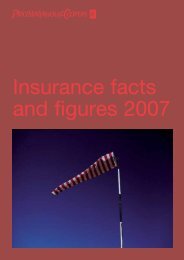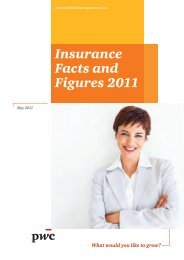Dataline A look at current financial reporting issues - PwC
Dataline A look at current financial reporting issues - PwC
Dataline A look at current financial reporting issues - PwC
You also want an ePaper? Increase the reach of your titles
YUMPU automatically turns print PDFs into web optimized ePapers that Google loves.
Time-charter contract: A time charterer enters into a contract with a ship owner<br />
for the use of a named cargo ship for 5 years. Under the time charter, cleaning<br />
services rel<strong>at</strong>ing to the cargo space or other relevant services, such as overseeing the<br />
loading and unloading of cargo and management of cargo <strong>at</strong> sea, are the<br />
responsibility of the ship owner in addition to maintenance and overhaul. Food and<br />
w<strong>at</strong>er for the captain and crew are also provided by the owner. The charterer may be<br />
chartering the ship either to carry its cargo or cargo owned by third-parties. The<br />
charterer pays a daily or monthly hire r<strong>at</strong>e, based on the market price <strong>at</strong> the d<strong>at</strong>e of<br />
the contract, for the use of the ship (including the captain) and also pays for the<br />
costs of all fuel consumed by the ship and all port fees. Additionally, the time<br />
charterer pays all cargo loading and unloading charges.<br />
Analysis — An assessment of whether this arrangement is a contract for<br />
transport<strong>at</strong>ion services or includes an embedded lease of the cargo ship is required.<br />
The conclusion will depend on whether the instructions provided in the time<br />
charter contract are deemed to convey the right to control the ship to the time<br />
charterer even though the captain and crew are provided by the ship owner.<br />
Parts supply contract: Purchaser P and Supplier S enter into a parts supply<br />
agreement for the lifetime of the finished product concerned. S uses equipment<br />
(th<strong>at</strong> is owned by S) th<strong>at</strong> can only be used to manufacture the parts required by P.<br />
The equipment is identified in the agreement and S could not use an altern<strong>at</strong>ive<br />
asset to manufacture the parts. The estim<strong>at</strong>ed capacity of the equipment is 500,000<br />
units, which corresponds to the total estim<strong>at</strong>ed production of units over the<br />
equipment's life cycle. P takes all of the output produced by S using the equipment.<br />
Analysis — An assessment of whether this arrangement is a contract for the<br />
supply of parts or includes an embedded lease of the equipment used to<br />
manufacture the parts is required. The conclusion will depend on whether P has<br />
the right to control the equipment based upon the extent of P's involvement in the<br />
design of, oper<strong>at</strong>ion of, and sourcing of the raw m<strong>at</strong>erials needed for, the<br />
equipment used to manufacture the parts.<br />
.50 Under <strong>current</strong> guidance, a conclusion th<strong>at</strong> a contract for services contains a lease<br />
would not have a significant accounting impact for lessees or lessors if the lease is<br />
classified as an oper<strong>at</strong>ing lease. However, this would have changed significantly under<br />
the initial ED. The judgment about whether a lease exists and the alloc<strong>at</strong>ion of contract<br />
consider<strong>at</strong>ion between the lease and non-lease elements would be much more important<br />
for these so-called "embedded leases."<br />
<strong>PwC</strong> observ<strong>at</strong>ion:<br />
Under <strong>current</strong> guidance, any embedded lease within an arrangement would often be<br />
considered an oper<strong>at</strong>ing lease. However, many lessees do not separ<strong>at</strong>e the embedded<br />
lease because the accounting for an oper<strong>at</strong>ing lease and a service/supply arrangement<br />
is generally the same (i.e., there is no recognition on the balance sheet and straightline<br />
expense is recognized over the contract period). This practice will change with<br />
the proposal to recognize leases on the balance sheet. Accordingly, there is likely to be<br />
a gre<strong>at</strong>er focus on identifying whether a component of an arrangement meets the<br />
definition of a lease.<br />
.51 During redeliber<strong>at</strong>ions, the boards affirmed the proposal in the initial ED to define a<br />
lease as “a contract in which the right to use a specified asset (the underlying asset) is<br />
conveyed, for a period of time, in exchange for consider<strong>at</strong>ion.”<br />
N<strong>at</strong>ional Professional Services Group | CFOdirect Network – www.cfodirect.pwc.com <strong>D<strong>at</strong>aline</strong> 19

















